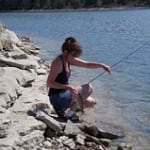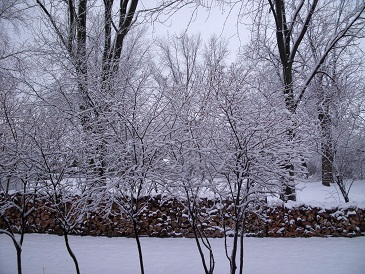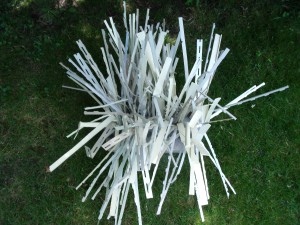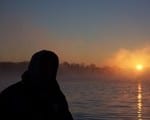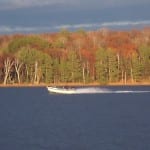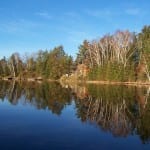Structure Fishing 101
By Paul Crawford
If there has been any real revolution in fishing over the last 20 years, it’s been “structure fishing”. Bass fishing as a sport, depended on shallow water “bank beating” since it’s inception. Over the last 20 years, it has become fashionable to wander off shore in search of more and bigger fish. Much has been written and discussed, but there still seems to be some confusion over structure fishing, even among the pros, and the majority of the fishermen have just become off shore fishermen, not structure fishermen. Let’s look at what we mean by structure fishing, and some of the tricks of the trade.
The definition of structure is a change in bottom contour, (I.e. depth), which results in an irregular feature on the bottom of the lake. Now just about any quick change in depth results in some type of structure, a hump, point, ledge, or something. The biggest misunderstanding seems to be the definition of “quick”. Quick is a relative term. In a traditional reservoir, this could be anything from a vertical drop to a gentle slope dropping 5 feet over a 30 yard distance. In a natural Florida lake, where it may normally take 1/4 mile to change depth by 1 foot, it may be a 6″ deep channel running through a 5 foot deep flat, or a two foot drop over 30 yards. Where ever you find it, structure is another edge in the underwater world, and we all agree that fish just love edges.
Let’s spend just a minute talking about what structure isn’t. Structure isn’t a weed bed on a flat, or an isolated stump, or a brush pile. All of these things are “cover”. A weed bed may constitute a different type of edge, both of the weeds and of the bottom composition, but not structure. Wood, whether natural or man made, is just some place to hide. Likewise, a feeding flat is a place, not a structure. We all have seen times when fish are on the flats and relating to cover. Even during those times, there will still be some fish around the surrounding structure. Even on days when the fish are straying away from structure, they generally won’t go that far if they don’t have to. Learn to recognize structure and it can narrow your search for fish dramatically.
Now that we can agree on what is structure and what is cover, we can also agree there are times when one or the other seems most important. Deep structure without cover can and does normally hold a few fish, but generally not a great concentration, at least of bass, (catfish and crappie are another story). And we blow by miles of shoreline or shallow water cover every trip that doesn’t have a concentration of bass. But put the two together, and you generally will find the fish stacked at least some of the time. The trick then is to know the other variables and be there at the right time. And every once in a great while we can find that honey hole with both structure and cover that have fish all the time, at least until we fish it out and have to find another one.
Types of Structure
We can define structure types by the relationship to the surrounding depths. The basic component of structure is the ledge. A ledge is simply a distinct change in depth. In a southern reservoir, this might be a drop of 5 feet over a twenty foot slope. In Florida, it is most times a drop of 6 inches to 1 foot over the same twenty foot slope. A ledge, by our definition, is a fairly straight line of depth change. Start putting some noticeable curves along the lip of a ledge, and you get other structure. A point is a protrusion of shallower water along a ledge. Surrounded by deeper water on three sides, it is the most recognizable and often the most productive type of structure. The opposite of a ledge is a cut. A cut is an indention in the line of a ledge with deeper water surrounded by shallow water on 3 sides. A hump is nothing more than a ledge that wraps around on itself, or an underwater island of sorts. A hump has deeper water on all sides. The opposite of a hump is simply a hole, literally deep water with shallow water on all sides. There are several other types we can talk about, but these are the basic types.
We now have our basic definitions, but we need to put some size restrictions on them, else everything is some type of structure. For instance, the main lake body could be seen as a hole, or simply a round set of ledges. We need to decide which one because we’d like to fish the structure differently depending on which type of structure we call it. As a reasonable guide, let’s look for just a second on how fish use structure. Structure, what ever it’s form, is a type of underwater transportation system. Fish generally follow a narrow depth getting from one place to another. The advantage of using structure edges is the deeper water provides an immediate escape route if you happen onto something much bigger than you. Now just like any road, fish rarely live right in the center lane. More likely, they will be just off one side or the other, which is were the cover part comes in. In any event, for our purposes, the extent or limit of a useful definition for a structure is the depth change itself and the reasonable area adjacent to the drop where fish will wander off to feed. In the case of our hole, a fish might reasonably wander out, say 100 feet into the hole without loosing the advantage of the edge for chasing shad. So, if we assume both sides of hole are good for 100 feet, then anything that is over 200 feet wide, at it’s narrowest part, isn’t a hole, just two separate ledges. Similarly, if a hole is too small to make use of each side, you have a ditch or a depression, not a hole. Each of these other cases may be useful, but for our discussion, they aren’t holes. Apply all of the same comments to the other structures: points, humps, cuts, etc.
Cover and Structures
Even with our size restrictions, we still have a tremendous area to work. But we can narrow the odds by putting one additional restriction on our prime structure. We already said we’d like structure with cover, but let’s now say we want the cover to end along the edge of our structure. A point with a grass bed is good. But if the grass bed happens to end right at the edge of the point, then the point is great!
Weed beds in particular are excellent types of cover to either change types, or stop all together right at the lip of the structure. A ledge may have heavy grass in say 10 feet on the top edge, while have either a different type of grass or, even better, no grass at all at the bottom edge. If you work the outside of the weed bed, you actually are working three edges at the same time, the vertical edge of the grass, the edge of the weed bed, and the depth change of the structure. Add a small point or cut in the straight ledge, and you have 4 or 5 edges. This is the kind of high percentage spot worth spending hours to find.
Standing wood is another case of cover at a structure. When you are fishing an old road bed or creek channel and the wood suddenly stops at a particular depth, you get all the advantages of the structure and the cover. I have found it necessary to be careful with defining wood on a ledge. Where you have creeks or roads, you a likely to also have hills or mounds. In this case you need to find a structure on a structure. Just because to the bed runs at a consistent depth, the top edge will, more often than not, rise and fall over mounds or small hills. A gentle slope up an underwater hill may concentrate the fish at a single tree because the depth is 6 inches different than the surrounding trees. If you don’t know what depth, it can be frustrating. On the other hand, a slight mount in on one side of a bed can act as a magnet for every fish in the area not actively hunting. Find an area with several of these mounds and you’ve got your honey hole. Depending on the local botany before it was flooded, you may be able to spot these mounds by looking for a specific type of tree which grew only on a mound or down in a cut. A perfect example is willow trees that would tend to have grown lower and closer to the water level of an old creek than say the surrounding oak trees. Cypress trees are another sure tip off of a change in structure level. You’ll read many times about a tournament won fishing a specific type of tree. More than likely, it wasn’t the wood type that made the difference, it was depth that type of tree was growing in before the lake was built. For more habitat ideas look at fishiding.com. the industry leader in artificial fish habitat and fish attractors.
Water Temperature and Structure
We’ve now established looking for a structure with cover, it’s time to chose among all structures with cover that ends at the structure edge. This will depend on several variables, water clarity, weather, season, stratification, temperature, etc. We could try to consider everything, but for starters, there is an easier way. Most of the changes can be interpreted as water temperature. Like any other generalization, it doesn’t work all of the time, but for 80 – 90% of the cases, it works just fine.
The general rule of thumb: “The Colder the Water, The Steeper the Drop.” Pretty simple, and it works. During winter and early spring, look for the fish to relate to a steep drop into deep water. This might be from 5′ or from 20′ into a deep hole, but the fast drop is the key. The fish will move during warmer periods to the upper shelf to feed and may suspend over the hole during those blue bird cold fronts. During summer and well into fall, look for a gentle slope into deeper water. The fish may range a couple of hundred yards from the structure but at least some will be on slope for most of the year. The only tough part about this is they may actually move deeper to feed and return to the slope to rest. But again, for the most part they will move into the cover for feeding while the bait is on the bottom.
Everything else being equal, we still don’t know at what depth we should look for our structure. In the Florida Chain Lakes, with different water clarity in different lakes, you can still find structure, with cover, the correct type of slope, and the correct contour in just about any depth. The tie breaker is again water temperature, just not surface temperature anymore. The most productive structure, all things being equal, will be where the structure tops out at the same depth as the thermocline. A thermocline, for those not normally worrying about those things, is a physical layer between two different temperatures of water. This normally exists when the lake is “stratified”, or during the summer when there is little movement between the upper and lower water layers. In this case, the cooler water will remain below the warmer upper layers. In the fall, as the upper water cools, it will normally fall within the water column, causing a lake to “turn over”, normally tough days to be fishing. Anyway, a structure near the thermocline with appropriate cover, can be a gold mine for fishing.
There are several ways to find a thermocline if one exists. The most obvious, and the most trouble, is to lower a temperature probe and look for a dramatic, (3 – 6 degrees), change in temperature. An easier way is to use your depth finder. A thermocline will reflect sound waves if the temperature change is great enough. Move to deep water and place your unit in manual mode. Increase the gain, (sensitivity), until you see a solid or broken line in the middle of the water column. If your depth finder has the little fish symbols on it, this may take the form of a line of fish around a particular depth. As you move the boat, this line may move slightly up or down, (a foot or so), but should remain pretty close for a given area. Find structure at that depth, and you should find fish. By the way, during the dog days of summer, you may find 2 or 3 thermoclines at the same time. Generally, the fish won’t be below the lower one, (commonly about 25′ in Florida). If you have 3 or more thermoclines, (more common on reservoirs where water 50′ plus is the rule), fish the middle one.
Fishing Structure
The absolute most important thing for fishing structure is your depth finder. A depth finder which can mark in 1/10′ or in inches is ideal for this application. Also, you’ll find it more comfortable if your depth finder is mounted on the bow with the transducer attached to the foot of the trolling motor. If you have only one depth finder, mounted on your console, then keep in mind the depth being shown is for the stern of the boat, not directly under you and your trolling motor. Get to be best friends with your depth finder, for structure fishing, it’s the most important piece of gear you’ve got.
Most of the time, you’ll find the majority of the fish on the top lip of the structure. The rest of the time, you’ll find the fish suspended just past the lower edge at approximately the same depth as the upper edge. Boat position is the key to effectively fishing the structure. Run up and down your structure a time or two and get to know the rate of the slope and where it bottoms out at. Position the boat so at a full cast length, your lure is about 10 over the top edge while holding the boat in deeper water. Keep the boat at the same depth as you follow the contours of the structure. If you find a narrow cut, back off and fish the bottom of the cut as well as moving in and fishing the surrounding lip. If you move over a point, make sure to go back and fish the normal edge line across the top of the point as well as following the point out into deeper water.
While you’re fishing the top of the ledge, don’t forget the deeper side of the boat. Every 6 or 8 casts, turn around and heave one out into open water. Make sure you monitor your bait on the drop, that’s were the bite will be for suspended fish. Pay particular attention to suspended fish around the ends of points and at the corner of flats. More to see in the fishiding news page
After you’ve finished a run on a structure’s top edge, if it still looks promising, make another pass fishing the bottom edge. Position the boat as close as you can to the top edge, (where you’ve just fished), and use your bait to “feel” you way along the bottom edge. If the cover stops on the top edge, many times a different scattered grass, limbs, or simply trash will pile up on the bottom edge. If you can’t feel anything, and when all else fails, you can count down your lure and get a pretty consistent feel for the depth you’re fishing. This is also the pass you’d like to fish straight across points and cuts looking for fish suspended in the middle. In general, this deep water pass will also be your best bet of sticking that kicker you’re looking for.
If you think there are some suspended fish in the area, try a long Carolina rig. Instead of simply pulling the bait along the bottom, pop the bait up in the water. As the sinker drops, the bait will actually whip upwards and you can effectively cover 6 or 8 feet off the bottom. In these situations, expect a very light bite and give the bait plenty of time to float back to the bottom before the next jerk. It won’t be unusual to not feel anything and simply have a fish on when you raise your rod. You can increase your hook up ratio by gently raising the rod tip and feeling for pressure before jerking the bait off the bottom. This is a prime example of the wisdom of the adage, ” The Jerk’s Free”.
There are a hundred other ways to fish various structures, and there are many more variations of the structures themselves. We’ll look in future articles at the more specific structures and techniques, but this pretty much covers the basics. Give structure fishing a try and I think you’ll like the results. Like most other techniques, it more a matter of confidence than anything. Given the right situation, structure fishing can open up a whole new world of schools of fish and big bites! See you off shore.
POND BOSS Magazine is the world’s leading resource for fish, pond and fisheries management information including discussions on muddy water, raising trophy fish, fish feeding, building a pond, algae control and more. Check us out at www.pondboss.com or contact Bob Lusk, the Pond Boss himself, at 903-564-5372. His books, Basic Pond Management, Raising Trophy Bass and Perfect Pond, Want One, may be purchased by calling 800-687-6075 or ordering online at www.pondboss.com


